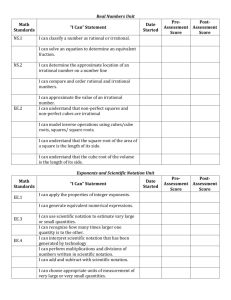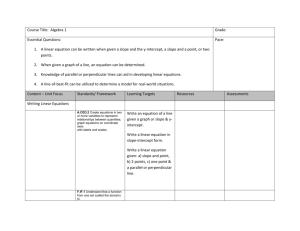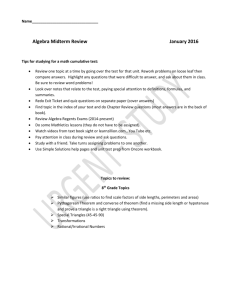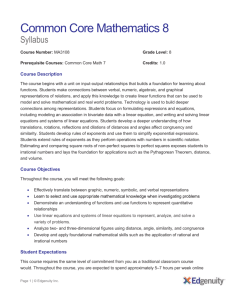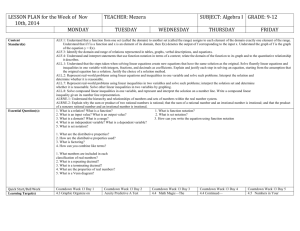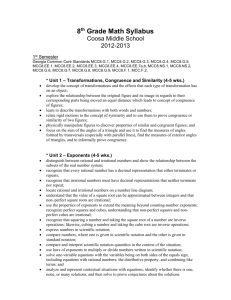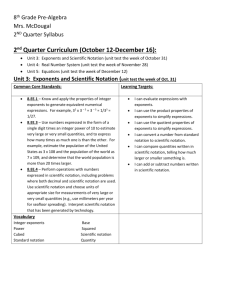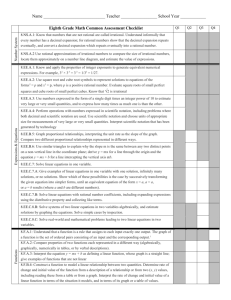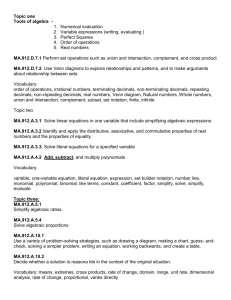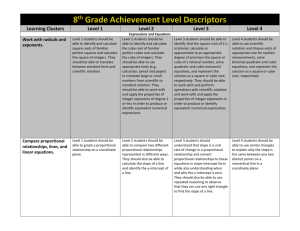I Can Statements
advertisement
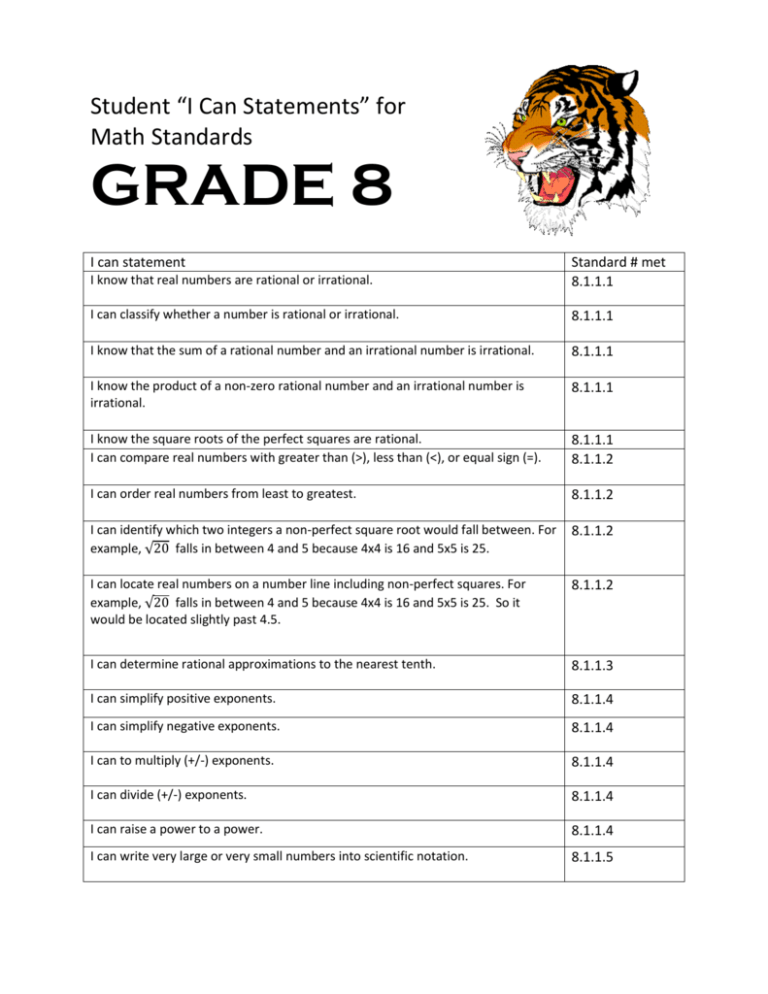
Student “I Can Statements” for Math Standards GRADE 8 I can statement I know that real numbers are rational or irrational. Standard # met 8.1.1.1 I can classify whether a number is rational or irrational. 8.1.1.1 I know that the sum of a rational number and an irrational number is irrational. 8.1.1.1 I know the product of a non-zero rational number and an irrational number is irrational. 8.1.1.1 I know the square roots of the perfect squares are rational. I can compare real numbers with greater than (>), less than (<), or equal sign (=). 8.1.1.1 8.1.1.2 I can order real numbers from least to greatest. 8.1.1.2 I can identify which two integers a non-perfect square root would fall between. For example, √20 falls in between 4 and 5 because 4x4 is 16 and 5x5 is 25. 8.1.1.2 I can locate real numbers on a number line including non-perfect squares. For example, √20 falls in between 4 and 5 because 4x4 is 16 and 5x5 is 25. So it would be located slightly past 4.5. 8.1.1.2 I can determine rational approximations to the nearest tenth. 8.1.1.3 I can simplify positive exponents. 8.1.1.4 I can simplify negative exponents. 8.1.1.4 I can to multiply (+/-) exponents. 8.1.1.4 I can divide (+/-) exponents. 8.1.1.4 I can raise a power to a power. 8.1.1.4 I can write very large or very small numbers into scientific notation. 8.1.1.5 I understand how calculators display numbers in scientific notation. 8.1.1.5 I can multiply and divide numbers written in scientific notation. 8.1.1.5 I know how to express answer in scientific notation using significant digits when asked for (or representing physical measurements). 8.1.1.5 I understand that the independent variable (input) determines the value of the dependent variable (output). 8.2.1.1 I can use functional notation, such as f(x), to represent this relationship. 8.2.1.1 In a given equation, I know which variable represents the independent variable and 8.2.1.1 which represents the dependent variable. I know that changing the input variable by a certain amount will change the output by a constant amount. 8.2.1.2 I know that a function is linear if the graph is a straight line. 8.2.1.3 I understand that an arithmetic sequence is a linear function. 8.2.1.4 I can write a linear function to model an arithmetic sequence in the form f(x) = mx + b where x = 0, 1, 2, 3 … 8.2.1.4 I understand that a geometric sequence is a non-linear function that can be expressed in the form f ( x) ab x , where x = 0, 1, 2, 3 … 8.2.1.5 I can write a linear equation for a given table. 8.2.2.1 I can write a linear equation for a given graph. 8.2.2.1 I can write a linear equation for a given verbal description. 8.2.2.1 I can make a table from a given equation. 8.2.2.1 I can make a table from a given graph. 8.2.2.1 I can make a graph from a given equation. 8.2.2.1 I can make a graph from a given table. 8.2.2.1 I can identify the slope from a linear function or equation when given a table, graph or equation. 8.2.2.2 I can identify the y-intercept from a linear function or equation when given a table, graph or equation. 8.2.2.2 I understand that the slope represents the rate of change. 8.2.2.2 I know when a table, graph, or equation represents a proportional relationship (direct variation). 8.2.2.2 I can describe how the coefficient (slope) affects the graphs of linear functions. 8.2.2.3 I can use a graphing calculator to examine the slope of a line. 8.2.2.3 I can use a given equation to make a table and graph representing an arithmetic sequence. 8.2.2.4 I can write an equation to represent a word problem that has an arithmetic sequence. 8.2.2.4 I can use an equation, table, and/or graph to solve the given problem involving arithmetic sequences. 8.2.2.4 I can use a given equation to make a table and graph representing a geometric sequence. 8.2.2.5 I can write an equation to represent a word problem that has a geometric sequence. 8.2.2.5 I can use an equation, table, and/or graph to solve the given problem involving geometric sequences. 8.2.2.5 I can evaluate algebraic expressions using order of operations when given a specific value for each variable. 8.2.3.1 I can evaluate algebraic expressions containing radicals. 8.2.3.1 I can evaluate algebraic expressions containing absolute values. 8.2.3.1 I can justify steps in equivalent expressions by identifying the properties of algebra used (associative, commutative, distributive). 8.2.3.2 I can justify steps in equivalent expressions by identifying the order of operations used, including grouping symbols. 8.2.3.2 I can use linear equations to represent situations involving a constant rate of change, including proportional and non-proportional relationships. 8.2.4.1 I can solve multi-step equations in one variable. 8.2.4.2 I can solve for one variable in a multi-variable equation in terms of other variables. 8.2.4.2 I can justify the steps by identifying the properties of equalities used. 8.2.4.2 I can write in equation of a line when given the slope and y-int. 8.2.4.3 I can write in equation of a line when given the slope and a given point. 8.2.4.3 I can write in equation of a line when given two points on the line. 8.2.4.3 I can put point-slope form into slope-int. form or standard form. 8.2.4.3 I can put standard form into slope-intercept form. 8.2.4.3 I can use linear inequalities to represent relationships in various contexts. 8.2.4.4 I can solve linear inequalities using properties of inequalities. 8.2.4.5 I can graph the solutions to linear inequalities on a number line. 8.2.4.5 I can represent relationships in various contexts with equations and inequalities involving the absolute value of a linear expression. 8.2.4.6 I can represent relationships using systems of linear equations. 8.2.4.7 I can solve systems of linear equations in two variables symbolically, graphically and numerically. 8.2.4.7 I understand that a system of linear equations may have no solution, one solution, or an infinite number of solutions (and relate the number of solutions to pairs of lines that are intersecting, parallel or identical). 8.2.4.8 I can check whether a pair of numbers satisfies a system of two linear equations in two unknowns by substituting the numbers into both equations. 8.2.4.8 I can use the relationship between square roots and squares of a number to solve problems. 8.2.4.9 I can use the Pythagorean Theorem to solve problems involving right triangles (solving for the leg and for the hypotenuse, solving to find the perimeter). 8.3.1.1 I can find the distance between two points (vertical points, horizontal points, using the Pythagorean Theorem). 8.3.1.2 I can informally justify the Pythagorean Theorem by using measurements, diagrams and computer software. 8.3.1.3 I understand that parallel lines have the same slope. 8.3.2.1 I understand that perpendicular lines have slopes that are negative reciprocals of each other (multiply to get -1). 8.3.2.1 I can analyze polygons on a coordinate system by determining the slopes of their sides (whether they are parallel or perpendicular). 8.3.2.2 Given a line on a coordinate system and the coordinates of a point not on the line, I can find lines through that point that are parallel and perpendicular to the given line, symbolically and graphically. 8.3.2.3 I can collect, display, and interpret data using scatter plots. 8.4.1.1 I can use the shape of the scatter plot to informally estimate a line of best fit. 8.4.1.1 I can use the shape of the scatter plot to determine an equation for the line. 8.4.1.1 I can use appropriate titles, labels, and units on a scatterplot. 8.4.1.1 I can use graphing technology to display scatter plots and display corresponding lines of best fit. 8.4.1.1 I can use a line of best fit to make statements about approximate rate of change. 8.4.1.2 I can use a line of best fit to make predictions about values not in the original data set. 8.4.1.2 I can assess the reasonableness of predictions using scatter plots by interpreting them in the original context. 8.4.1.3
